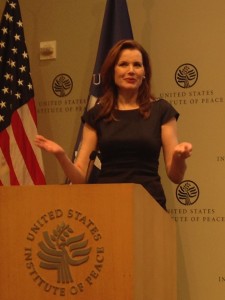Join Me Next Month at the Bentonville Film Festival with Geena Davis, Celebrating Women and Diversity in Film
Posted on April 2, 2015 at 8:00 am
Join me next month in Bentonville, Arkansas, for the Bentonville Film Festival with Geena Davis!
Posted on April 2, 2015 at 8:00 am
Join me next month in Bentonville, Arkansas, for the Bentonville Film Festival with Geena Davis!
Posted on September 24, 2014 at 10:49 am

Yesterday, I was honored to attend the Second Global Symposium on Gender in Media, held a the United States Institute of Peace in Washington, D.C. The keynote was delivered by Oscar-winning actress Geena Davis, founder of the Geena Davis Institute on Gender in Media. The highlight of the event was the presentation of new research by Dr. Stacy Smith, Ph.D. and her team at the USC Annenberg School for Communication & Journalism, looking at gender bias in films produced by the 11 countries with the most established film industries. Films jointly produced by the US/UK and those from India had the poorest results in portraying women, whether the issue was number of speaking parts/named characters or number of women in professional roles. Perhaps the most surprising result was that even in crowd scenes, women made up only about 17 percent of the roles. Movies portray a world in which women are outnumbered by men five to one. The study also found that women filmmakers — directors, producers, and writers — usually put more women on screen, except that as the budget increases, the number of female characters goes down. “We are responsible for exporting negative images of women around the world,” Davis said. Female characters are too often one-dimensional, skimpily clothed, sexualized, and portrayed as victims of violence. “The more TV a girl watches, the fewer options she thinks she has. The more TV a boy watches, the more sexist his views become.” Her approach is “collegial, private” meetings with filmmakers, who all insist that “it’s been fixed,” but are responsive to the data she presents. “Gender inequality is rampant,” concluded Dr. Smith. “Cinema turns a leering lens on females.” One element of her study revealed only three female characters in positions of political power. Two were portrayals of real-life leaders Margaret Thatcher and Angela Merkel. The third was an animated elephant. On screen, females hold only 22.5% of the jobs, as opposed to 40% in real life. Davis called on filmmakers to go through scripts and assign female names to half of the characters and make sure crowd scenes had gender parity. “I’m not asking them to add a message, just to recognize the message already created. Let’s not embed harmful and disempowering messages in media aimed at kids.”
Posted on December 13, 2013 at 3:58 pm
Oscar-winning actress Geena Davis has been a leader in understanding and improving the role of women in media. The founder of her namesake Institute on Gender in Media wrote a piece for the Hollywood Reporter citing data showing that there are three male characters for every speaking female in family-rated films: “We are in effect enculturating kids from the very beginning to see women and girls as not taking up half of the space.”
She proposes “two easy steps” for change.
Step 1: Go through the projects you’re already working on and change a bunch of the characters’ first names to women’s names. With one stroke you’ve created some colorful unstereotypical female characters that might turn out to be even more interesting now that they’ve had a gender switch. What if the plumber or pilot or construction foreman is a woman? What if the taxi driver or the scheming politician is a woman? What if both police officers that arrive on the scene are women — and it’s not a big deal?
Step 2: When describing a crowd scene, write in the script, “A crowd gathers, which is half female.” That may seem weird, but I promise you, somehow or other on the set that day the crowd will turn out to be 17 percent female otherwise. Maybe first ADs think women don’t gather, I don’t know.
As Davis says, “If they can see it, they can be it.”
Posted on September 20, 2013 at 8:00 am
For more information: Institute on Gender in Media
Posted on September 16, 2013 at 8:00 am
For more information: Institute on Gender and Media